This post and the photos within it may contain affiliate links. If you purchase something through the link, I may receive a commission at no extra charge to you.
If you want to learn how to start with calligraphy, you’ve come to the right place.
On this page, you will find everything you need to know about what calligraphy is and how to get started with it.
Whether you’re just starting with calligraphy or have been practicing for a while, this page contains many valuable resources to help you learn and improve your calligraphy skills.
Let’s get started!
Note – This page is consistently updated as I create new helpful resources.
What is calligraphy? In simple words.
Calligraphy is a visual art form that creates decorative handwriting using specific tools.
In other words, calligraphy is the art of beautiful writing.
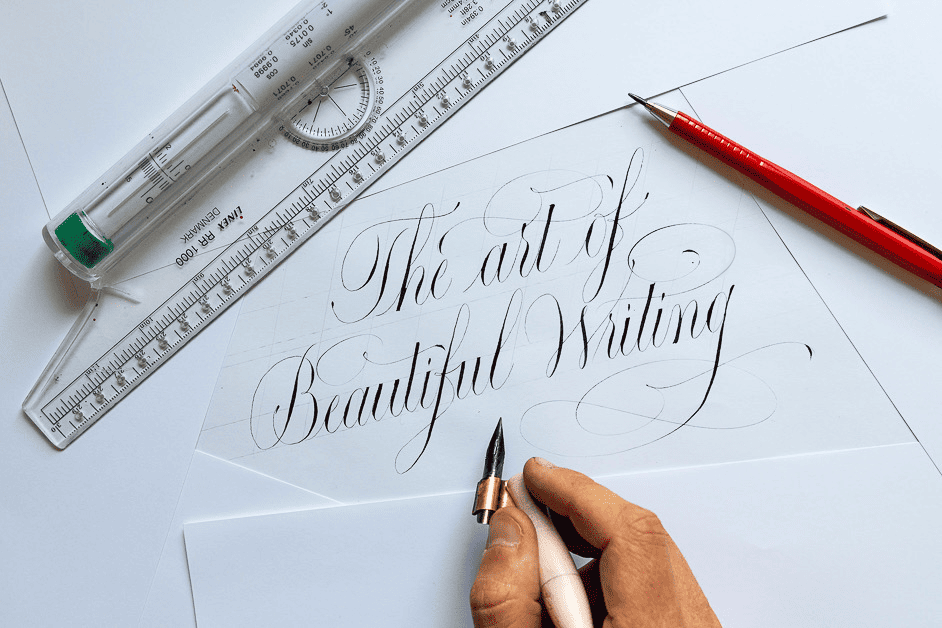
However, calligraphy is a broad term that encompasses a wide variety of styles and cultures from every corner of the globe.
We can primarily divide calligraphy into different cultures around the world.
To name a few –
- Western calligraphy (the Latin alphabet)
- Chinese calligraphy
- Japanese calligraphy
- Arabic calligraphy
- Indian calligraphy
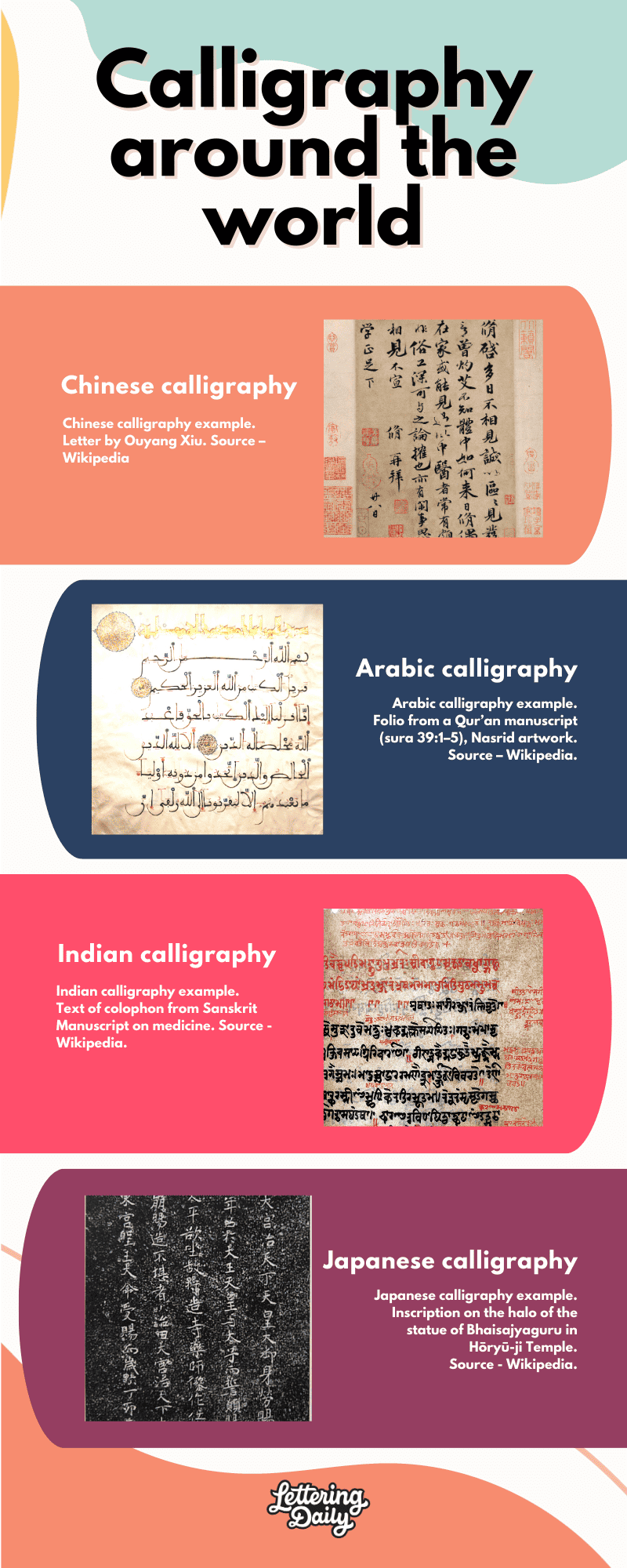
Note: Despite the art of beautiful writing being present in many cultures across the globe, I focus primarily on studying, practicing, and teaching Western calligraphy and the Latin alphabet.
What are some key features of calligraphy?
It’s important to distinguish between handwriting (including cursive) and calligraphy.
It is common for the untrained eye to see these two as the same.
With that in mind, here are a few key features of calligraphy.
1. Variation in stroke thickness.
Calligraphy can be done with any writing tool; however, there are specific tools dedicated to calligraphy.
The two most common tools are broad-edged and pointed pens.
These tools are specific for calligraphy because they can create stroke thickness variations.
The broad-edged nib achieves that by keeping the pen at a consistent angle (and the direction of movement), whereas the pointed nib achieves that by adding/removing pressure as you write.
The contrast in stroke thickness that these tools can create while you write is one of the most prominent features of calligraphic letters.
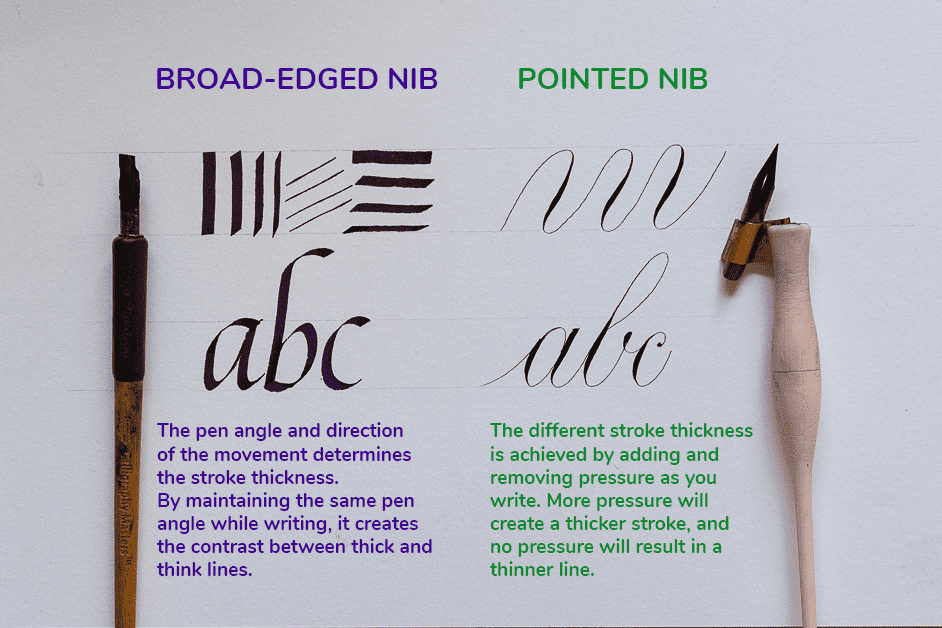
2. Letterform proportions and structure.
A specific proportion and structure of letters are maintained throughout the writing.
This is particularly important for traditional calligraphy scripts.
For example, Blackletter calligraphy is created with a broad-edged tool.
The angle of the pen is held at a 45-degree angle.
The letters are completely vertical, and they are proportionally sized according to the width of the pen.
That’s why we use the pen width as a measuring unit when it comes to broad-edged (flat tip) calligraphy styles.
These are just some of the “rules” you need to follow to create this particular style of calligraphy.
Calligraphy guidelines allow us to focus on creating beautiful and consistent letterforms.
Without calligraphy guidelines, you would have to guess and eyeball all the sizing and proportions, and it would make the whole process much more difficult.
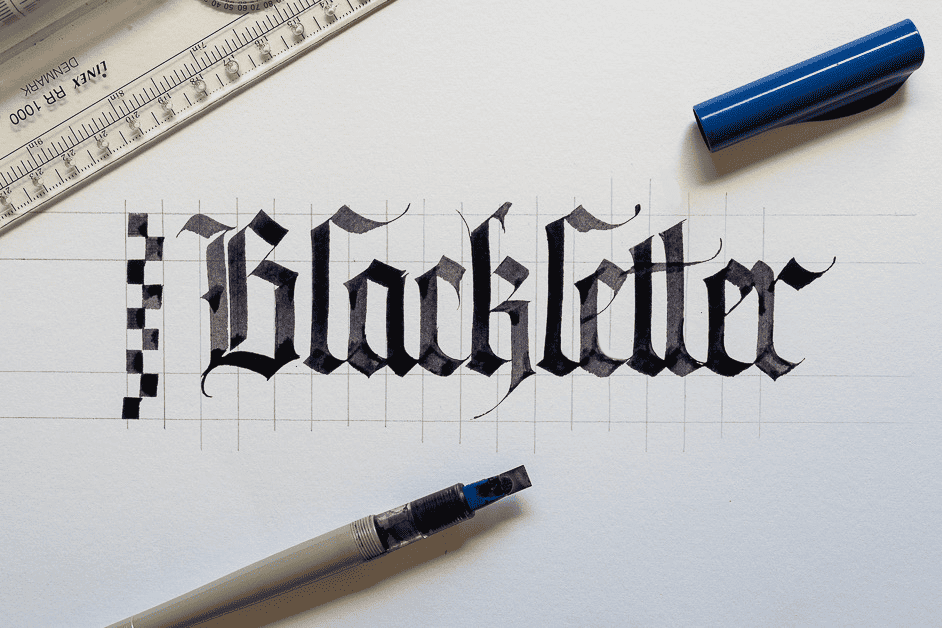
3. Consistency and uniformity.
Calligraphy places great emphasis on consistent and uniform letterforms.
Achieving consistent stroke widths, angles, spacing, rhythm, etc., and overall letter shapes throughout a piece of writing is essential for creating a cohesive and visually pleasing result.
In the example below, I am using two different colored brush pens along with the basic calligraphy strokes to write out the word minimum.
I am focused on maintaining consistent spacing, slant, space within the letters (also known as counters), etc.
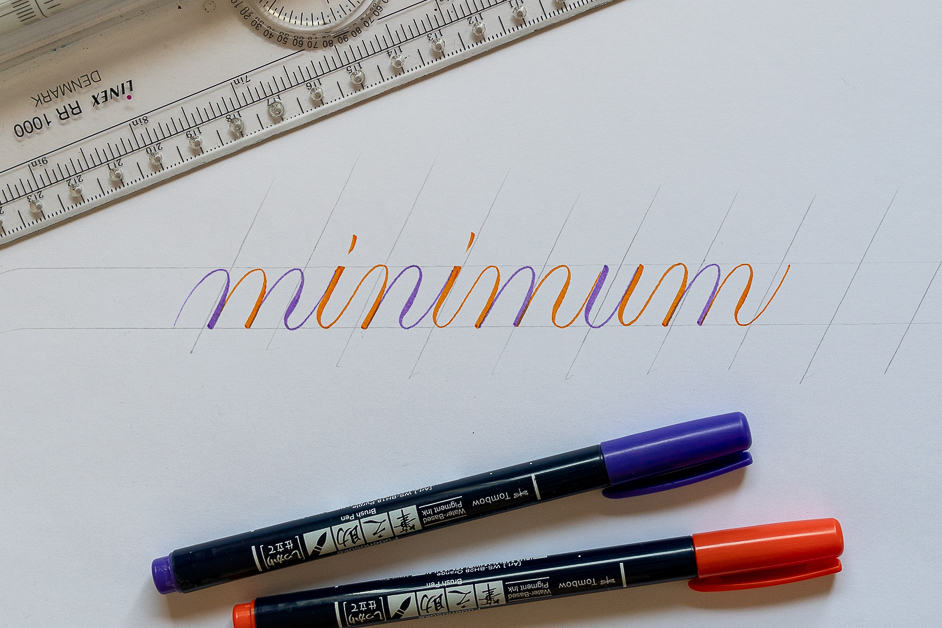
What is calligraphy used for?
Today, calligraphy is used in many different ways.
From personal use as a relaxing hobby and artistic expression to commercial purposes, official documents, wedding invitations, font designs, and much more.
The written word can be used to convey not only information but also emotions.
As you can see in the image below, the same sentence written in two different styles can communicate a very different feeling.
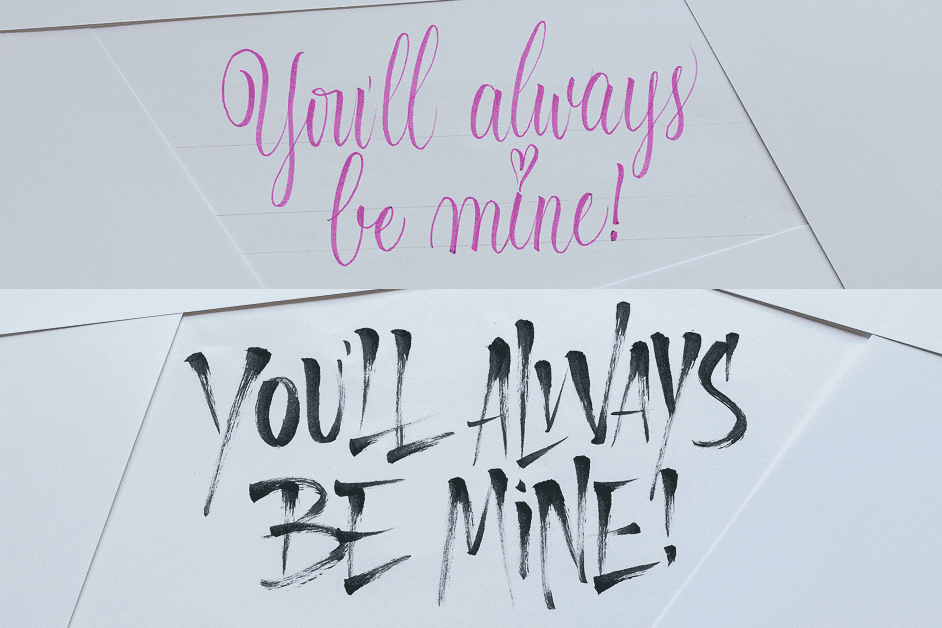
Often we don’t pay any attention to letters used in advertisements, logotypes, and other promotional materials.
Try to pay more attention the next time you’re in the city or any other place where you can see letters around you.
Take a moment to look at the letters and think about what they communicate on an emotional level and how they make you feel.
This could also be a helpful exercise to determine what sort of style of calligraphy you want to learn and practice.
At this point, it’s also important to mention that calligraphy and hand lettering are not the same thing.
Despite the fact that these two terms are often used interchangeably.
When doing calligraphy, you’re writing letters, whereas, with hand lettering, you draw them.
I wrote an article about the difference between hand lettering and calligraphy. Check it out!
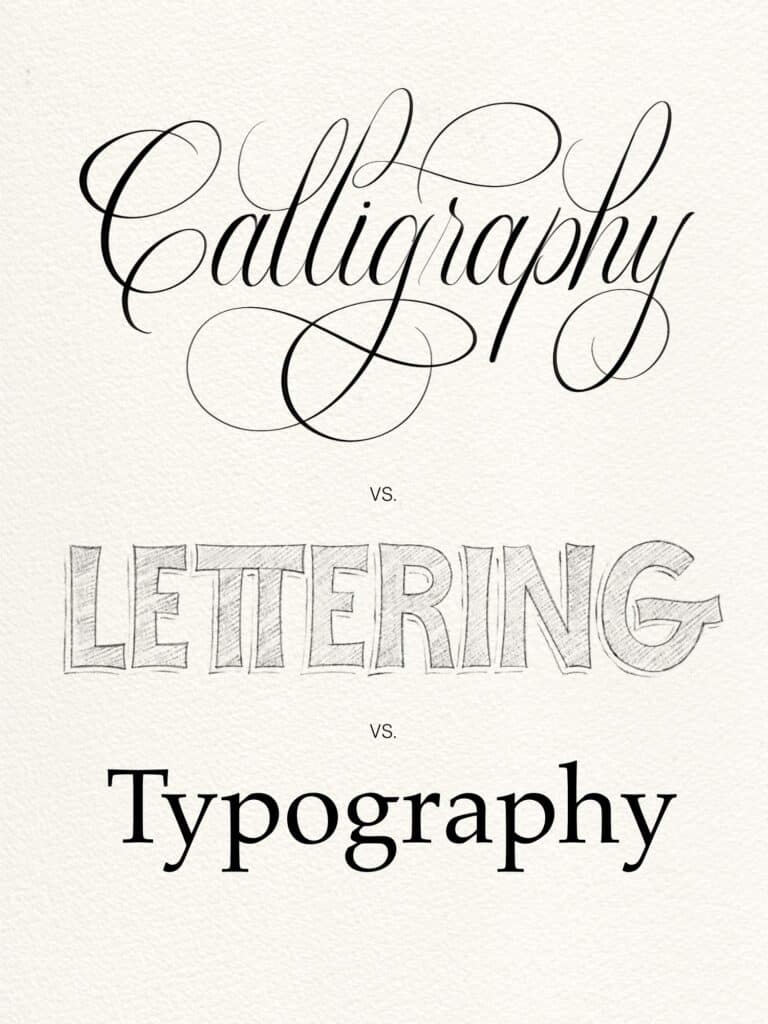
The Origins Of Calligraphy
Paleographers and historians believe the first alphabet evolved in Phoenicia around 1200 B.C.

As Phoenicians merchants traveled and traded across the Mediterranean, the Greeks adopted their alphabet around the eighth century B.C.
Soon after, the Etruscans adopted (and adapted) the Phoenician alphabet, which the Romans subsequently took.
By the first century B.C., the Romans had already developed several scripts using the Latin alphabet, which we all know and use today.
The word calligraphy derives from the Greek words “kallos” (beauty) and “graphein” (to write).
According to Britannica.com, the word calligraphy entered most European languages by the end of the 16th century.
This was initiated by the introduction of the printing press in the mid-15th century and thus created a clear distinction between handwriting and more elaborate forms of lettering.
We often take it for granted, but the written word is one of the foundations of human civilization.
Writing has allowed us to share and preserve information, ideas, and knowledge for thousands of years.
The history of calligraphy is rich, with many evolutions throughout centuries.
Below you can see a shorter general overview of how the Latin alphabet evolved throughout history.

In case you want to learn more about the history of calligraphy, I’ve written a separate in-depth article on the history of calligraphy and how it evolved throughout the years.
How to get started with calligraphy? The three-step formula
Ok, now we know what calligraphy is, what it is used for, and where it comes from.
Now it’s time to learn how to start learning and practicing calligraphy.
If you’re a complete beginner, the best way to start learning calligraphy is by following the three-step formula :
- Choose a calligraphy style that you want to study and practice.
- Pick the correct calligraphy pen for the style you want to practice + the essential calligraphy tools.
- Find a proper study resource and create an effective practice routine.
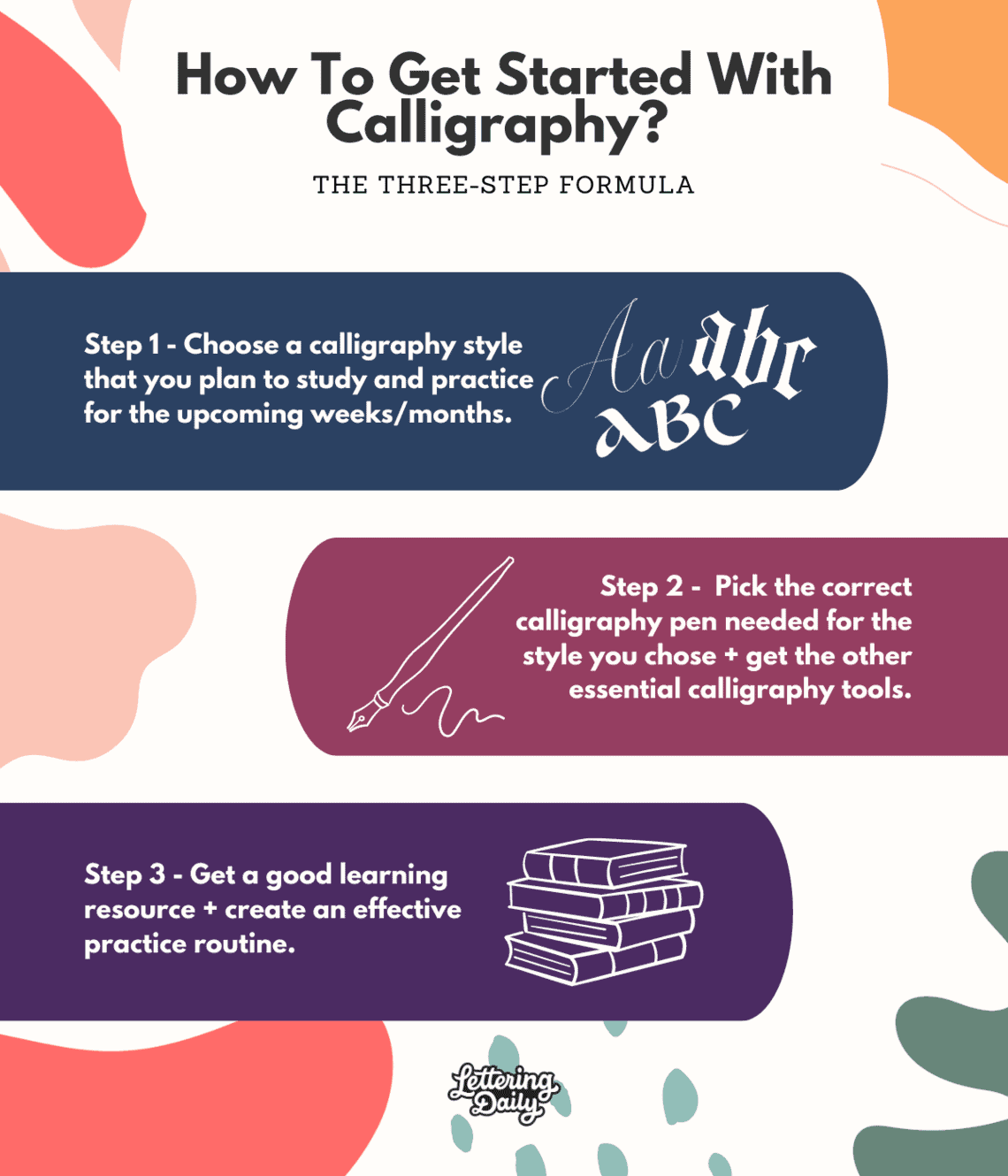
With that in mind, let’s have a closer look at each of these three key steps.
Step 1 – Choosing a calligraphy style
The first thing you should do is find the calligraphy style that appeals the most to you.
This is the first step since the next step (picking the tools) will depend on your calligraphy style, aka script choice.
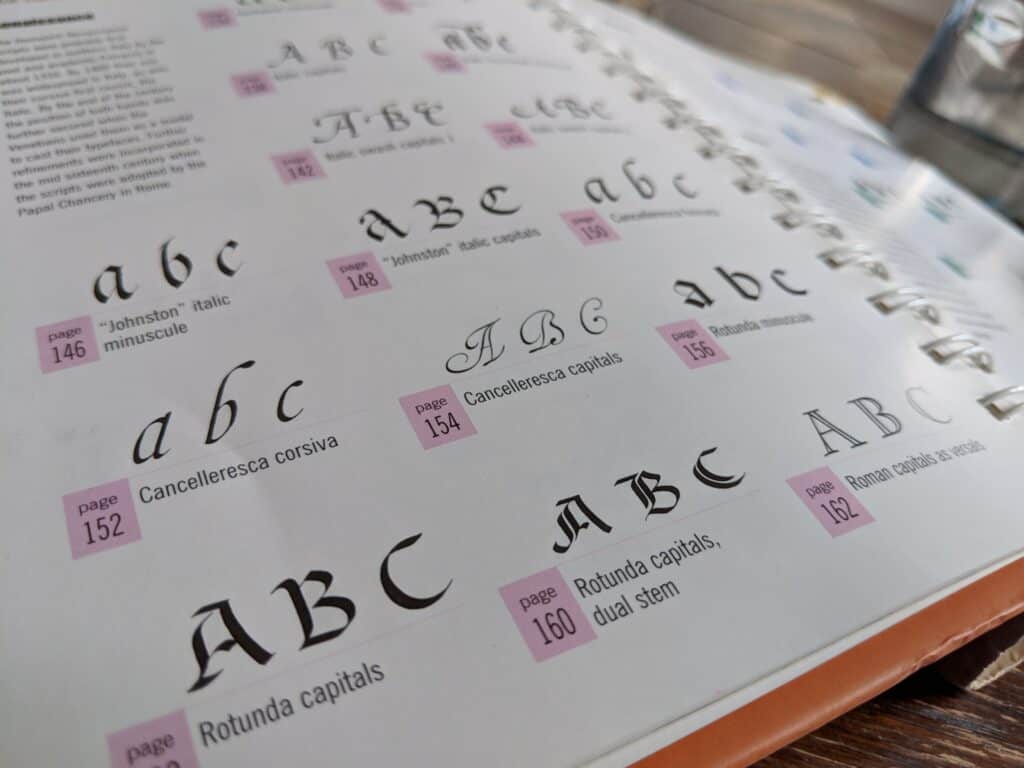
I often get asked what is the easiest calligraphy style to start with, and the truth is that each style has its little nuances that will create challenges along the way.
Some people might find working with a pointed nib easier, while others find it more comfortable with a broad-edged pen.
To learn, understand, and properly execute a specific calligraphy style, you need to stick to it for an extended period, so it’s essential that you choose something that is appealing to you.
Generally speaking, there are a few main categories of calligraphy styles.
We can categorize calligraphy styles according to the type of pen we use. The main categories are –
- Pointed nib calligraphy styles (Copperplate, Spencerian, etc.)
- Broad-edged calligraphy styles (Uncial, Gothic, Foundational, etc.)
- Brush pen calligraphy
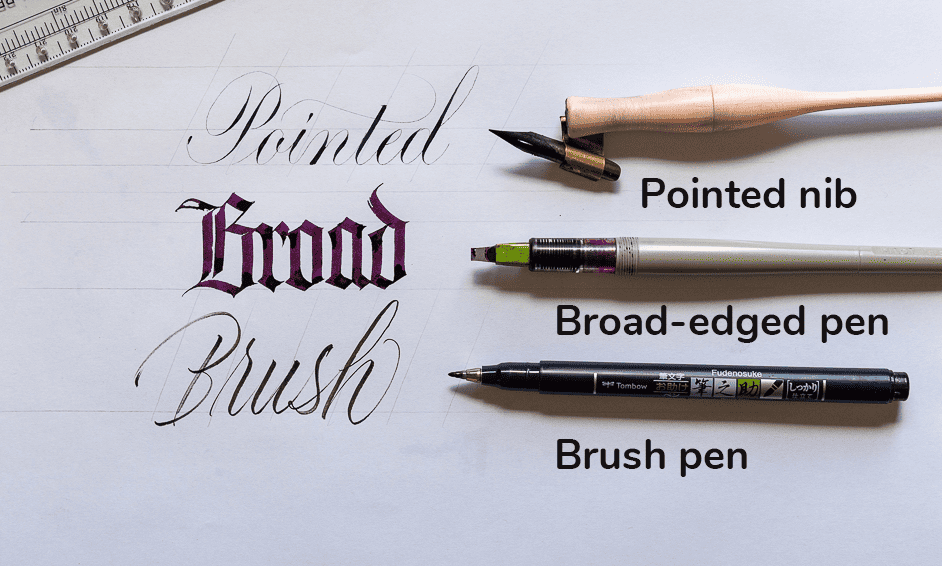
To make it easier for you, I created a separate guide on the 10 best calligraphy styles for beginners.
That article contains the most popular calligraphy styles and many helpful resources to help you make the right first step.
So if you’re a complete beginner, make sure to check out that article first.
Quick note: The different calligraphy styles are usually referred to as scripts. People commonly use the term “calligraphy fonts,” but that is incorrect. Fonts are what (today) computers use to display text.
Step 2 – Picking the correct calligraphy pen + the essential calligraphy tools
Remember, not every calligraphy pen suits every style.
This is why it’s crucial to pick the style and then the calligraphy pen that fits that style.
Entry-level pens and tools are not crazy expensive, but it would be silly to waste your money simply because you didn’t know what you needed to get started.

Luckily, with one pen, you can create a bunch of different styles.
On top of that, there are only three main pen categories to choose from.
To help you find the right pick, I have created a complete in-depth guide on choosing the right calligraphy pen.
In addition to the calligraphy pen, you will also need the basic calligraphy tools.
The basic calligraphy tools are :
- The calligraphy pen
- Paper
- Ruler
- Pencil
- Eraser
- Calligraphy ink
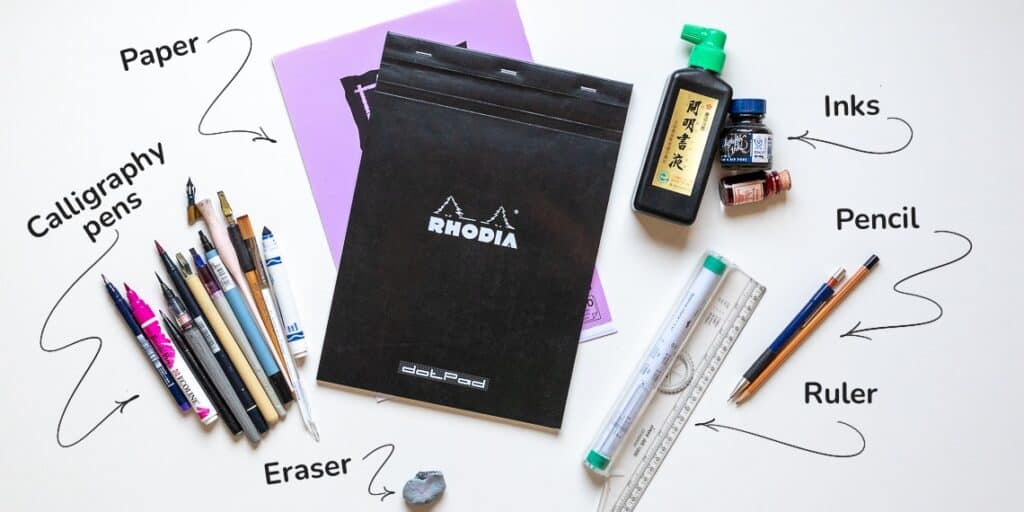
To learn more about this, I created a separate article on the 6 essential calligraphy tools.
By following these two guides, you will find the correct high-quality tools without wasting your time or breaking the bank.
What if you cannot afford or find any calligraphy tools in your area?
Fear not!
I wrote a tutorial where I show you how to create calligraphy with a regular pen, and if you have a pencil lying around, you can also do calligraphy using just a pencil.
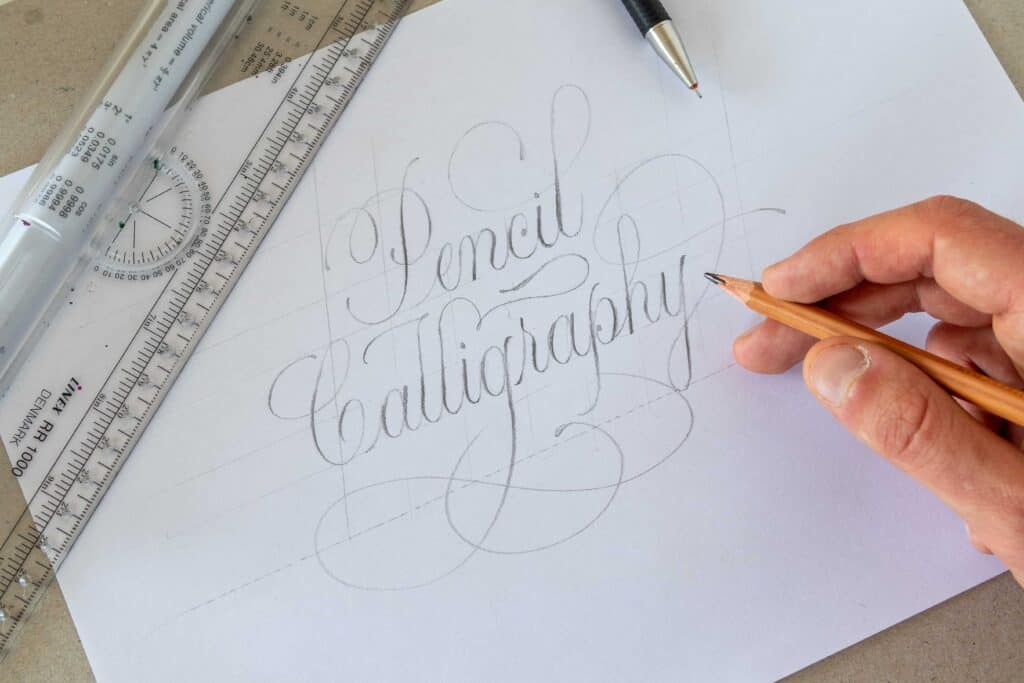
Other articles about calligraphy tools you might be interested in checking out :
- Calligraphy Paper – The Ultimate Guide For Beginners
- 10 BEST Brush Pens For Calligraphy Beginners
- 10 Useful Lettering And Calligraphy Tools
- How To Clean Your Calligraphy Nibs (5 EASY Ways)
- How To Make A Calligraphy Pen At Home
- Lettering & Calligraphy Gift Ideas (The ULTIMATE Guide)
Step 3 – Find a proper study resource and create an effective practice routine.
Once you’ve picked out the calligraphy style and the needed tools, it’s time to find a proper resource and start practicing.
One of the best ways to learn calligraphy is by attending an in-person workshop hosted by a professional calligrapher.
An online workshop is also great.
However, you can still find a bunch of great free resources online.
Instructional calligraphy books are also fantastic – I’ll talk more about them later on.
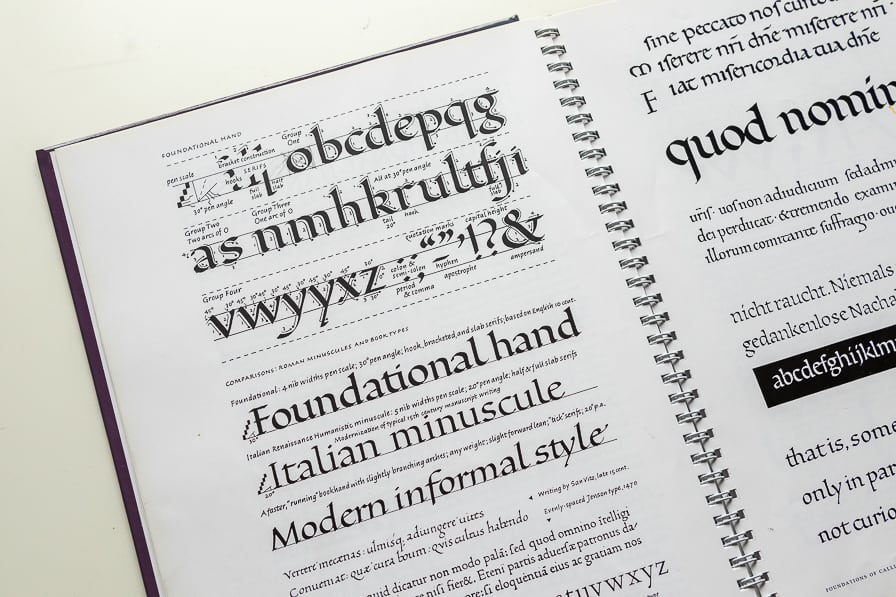
With the help of a good study resource, you’ll learn how to construct letterforms properly and keep your calligraphy proportional, consistent, and well-balanced.
Basically, all the elements you need to develop a strong foundation upon which you can then easily build more complex elements and learn new calligraphy styles.
You could just find an alphabet from Google Images or Pinterest and copy that for several months, but you might do more damage than good with that approach.
It’s much better to practice with a correctly structured exemplar that has a ductus along with it.
An exemplar is a full alphabet demonstration for you to use as a reference.
The ducts are the little red arrows indicating the stroke sequence to construct the letters. You can see an example of it below.
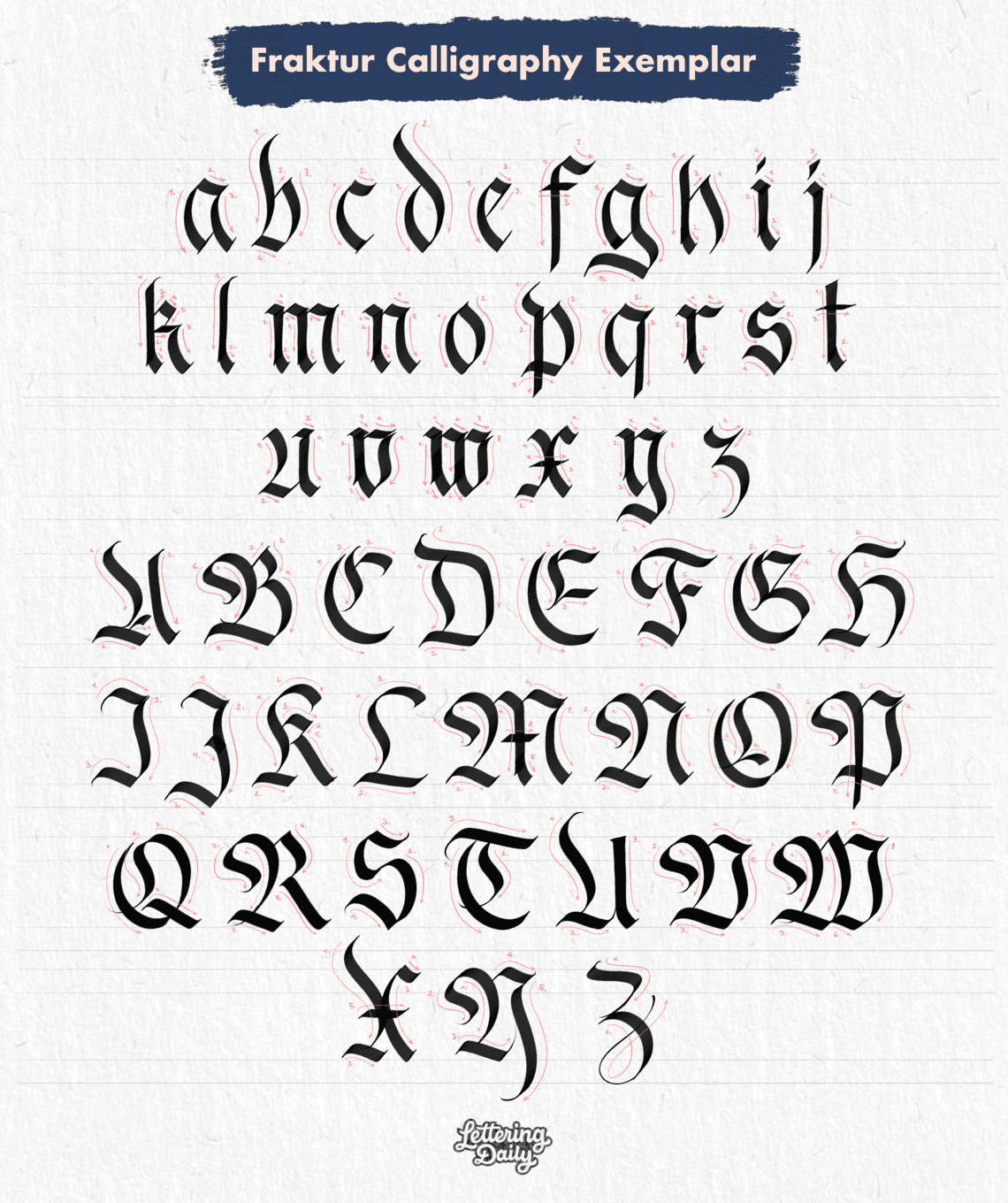
Trust me when I say this – finding a good study resource could make a massive difference in the quality of your calligraphy artwork and how quickly you can learn and improve your skills.
Here is a list of current step-by-step guides for various calligraphy styles that you can find on the Lettering Daily website –
- Blackletter/Gothic Calligraphy For Beginners (+FREE Worksheets)
- Fraktur Calligraphy Tutorial for Beginners (+FREE Worksheets)
- Italic Calligraphy For Beginners (+FREE Worksheets)
- Copperplate Calligraphy For Beginners (+FREE Worksheets)
- How To Get Started With The Foundational Hand (+FREE Worksheets)
- How To Do Modern Calligraphy (+FREE Worksheets)
- Brush Calligraphy Alphabet – a to z (Lowercase Letters)
- How to Do Faux Calligraphy (+FREE Worksheets)
- How To Do Pencil Calligraphy For Beginners (+FREE Worksheets)
- How To Get Started With Dip Pen Calligraphy (+FREE Worksheet)
- How To Do Calligraphy With Crayola Markers
- How To Draw Illuminated Letters
- How To Improve Your Handwriting (+FREE Worksheets)
This list will grow with time as I keep creating and adding more tutorials.
Creating an effective practice routine.
Calligraphy is a motor skill.
This means that the brain, muscles, and nervous system all need to work together.
It also means that building muscle memory requires a lot of practice.
In other words, the more you practice, the better you will become at calligraphy.
This is one of my favorite videos that describes in detail how practice helps us to improve any sort of skill :
However, it’s not just about the consistency of your practice that matters.
It’s also the quality of your practice that is crucial.
If you’ve been reading my articles or will be reading them, you will often see me repeat the following sentence: Consistent practice is important, but how you practice makes all the difference.
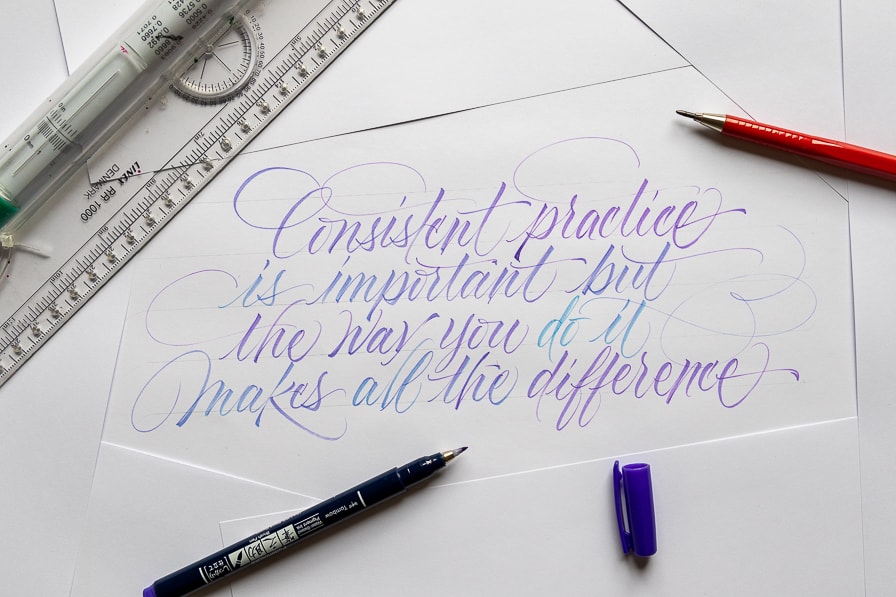
Over the years, I’ve seen some people progress more in six months than others in several years.
The key difference was almost always the way they practiced.
I cannot stress enough how important it is to create a good and effective calligraphy practice routine and how big of an impact it can have on your progress.
I also want to point out that it’s important that you make the routine fun.
Aimlessly copying basic strokes and alphabets can quickly become tedious.
I created a separate article on how to practice calligraphy effectively.
In that article, I share many helpful tips and a suggested practice approach that works for any calligraphy style you choose to practice.
On top of that, you can check out my article on the most common calligraphy mistakes and how to avoid them.
Additional learning resources for calligraphy
Alternatively, to the options mentioned earlier, calligraphy books can be a fantastic learning option.
Over the years, most of my calligraphy knowledge has come from calligraphy books.
I wrote an article sharing my top 10 calligraphy books for beginners.
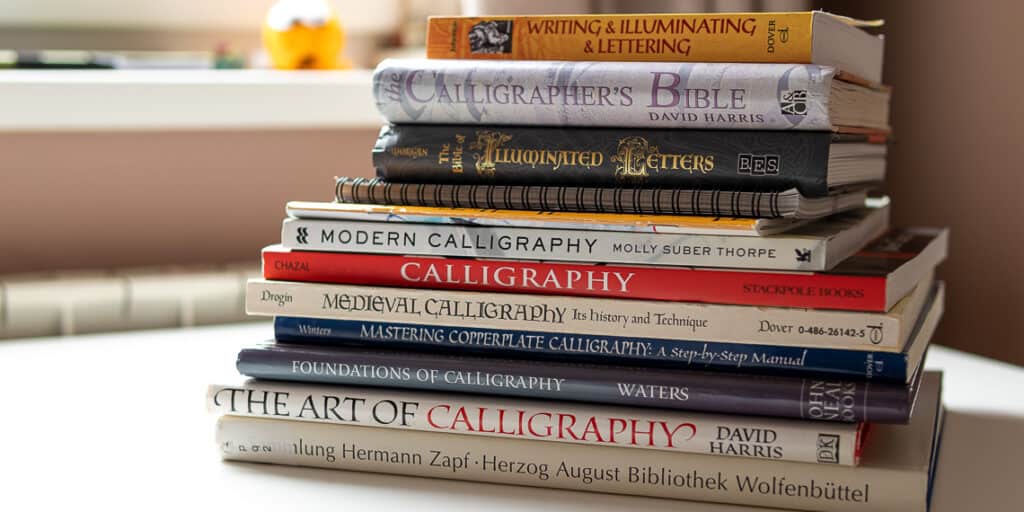
Other options are also online courses.
For example, Domestika and Skillshare offer some great online courses to help you start your calligraphy journey.
I also wrote an article sharing some of my favorite online calligraphy courses.
I prefer live or online workshops over courses (even if they are more expensive) because you can interact with the teacher, ask questions and get detailed feedback on your work.
Advanced calligraphy techniques and effects
Once have you covered the calligraphy basics, you can start experimenting with more complex effects and techniques.
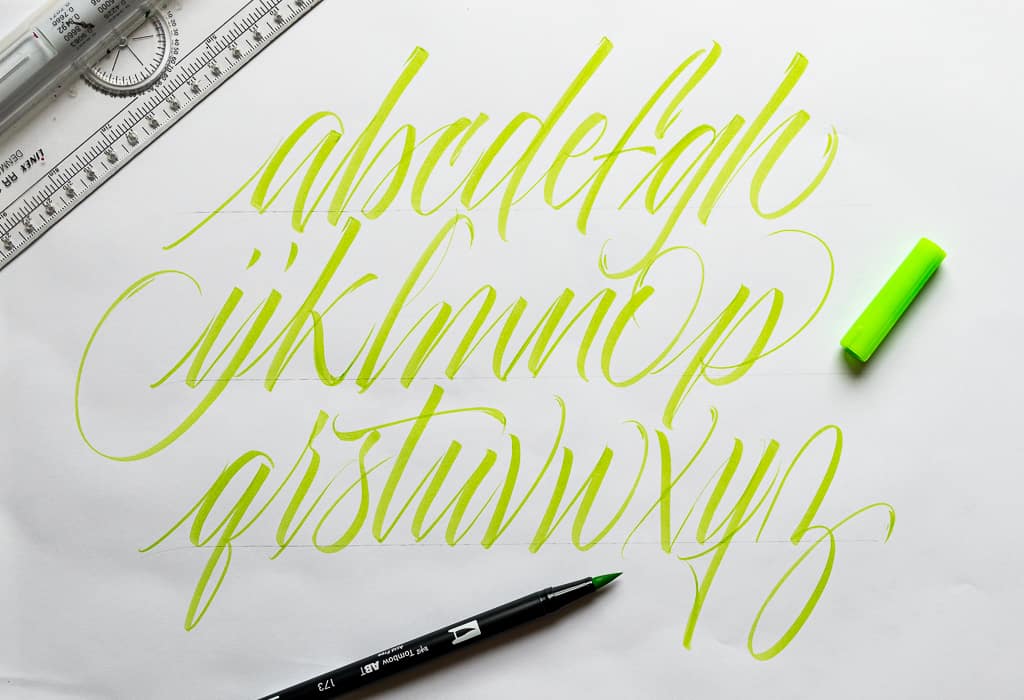
However, it is crucial that you go over the basics before you try different techniques and effects.
Below you can see a list of various tutorials and guides for calligraphy techniques and effects you can add to your work :
- How To Add Shadows To Your Letters (5 EASY Ways)
- How To Do Calligraphy Flourishing (+Free Worksheets)
- How To Dry Emboss Your Lettering By Hand
- Color Fundamentals, And How To Use Them In Your Lettering
- 5 Ways You Can Add a Gradient To Your Lettering
- How To Make A Calligraphy Pen At Home
- How To Vectorize Your Hand Lettering (4 EASY Steps)
- How To Create A Calligram (Step-By-Step Tutorial)
- How To Create Brush Lettering Compositions With Ease
- How To Become Ambidextrous (Beginners Guide 2023)
- How To Do Water Brush Lettering (+FREE Worksheets)
Frequently asked questions about calligraphy
Here are some questions (and answers) that I get from calligraphy beginners :
Recap + Final words
Pin me!
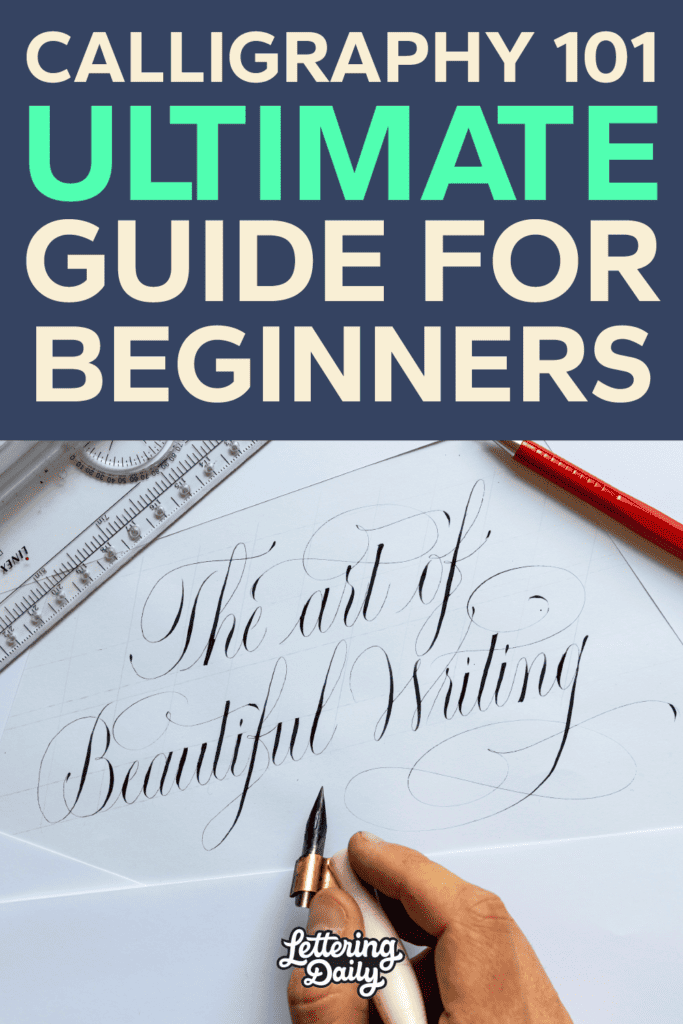
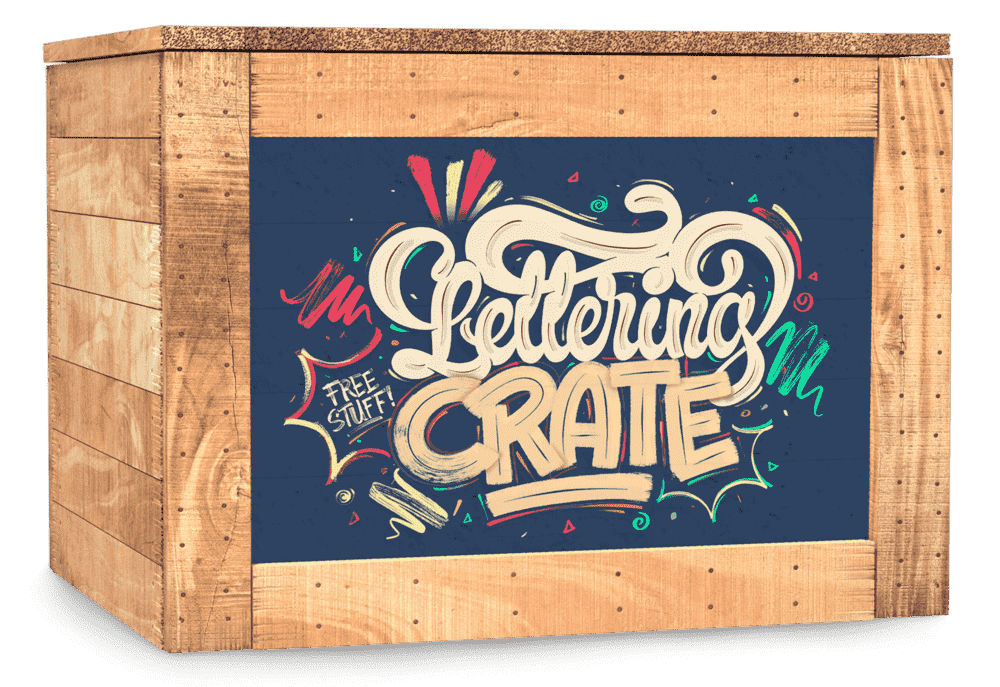
Stay updated with my tutorials and get instant access to the Lettering Crate –
A growing library of free lettering & calligraphy resources that includes –
About the author

Hey, I’m Max Juric, and I’m deeply passionate about calligraphy and hand lettering.
I’ve spent years honing my skills in the art of lettering, working with hundreds of clients from all over the world on design projects such as logotypes, branding, custom lettering, murals, and more.
But my journey doesn’t end there. I’ve also dedicated myself to sharing my knowledge and expertise with others, creating a wealth of resources including tutorials, articles, and podcasts.
It’s been incredibly rewarding to see thousands of people engaging with my content each month. Knowing that I’m helping fellow enthusiasts grow and develop their skills makes me really happy.
Welcome to Lettering Daily, your hub for all things lettering and calligraphy. Whether you’re a seasoned pro or just starting out, I’m here to inspire and guide you on your lettering journey. Stick around, and let’s explore the world of letters together!

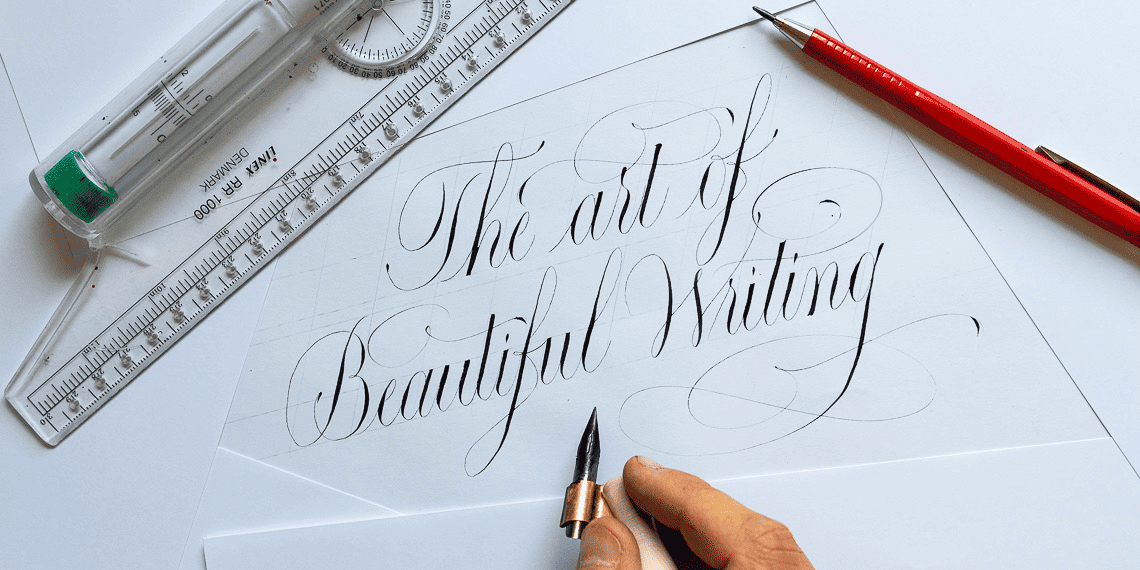
Thank you for all the content you have created and I look forward to what’s next. I love writing poems and I always thought poems look so boring on paper because I am not very good at drawing. So at a very young age I started to obsess over pretty writing, that’s how I came to my obsession with dip pen calligraphy. I love copperplate and spencerian
Hey Jillian, thank you so much for the kind comment 🙂 Would love to see some of your Copperplate and/or Spencerian.
Thanks Max for your newsletters and for this Calligraphy 101 Guide, plus all the extra topics and articles.
Something you could put in your newsletter is where you get your calligraphic supplies and books from–Amazon, local art store, etc.
Typism 2023 starts next week. I wonder if anyone is going to teach a class geared toward calligraphic art, mementos and such, for the 2024 Paris Olympics? (hopefully, the civil unrest will get settled). I took Natalie Brown’s Greeting Card 101 class, Typism 2022. Nice class, but am having difficulty with understanding PS/AI Pen Tool technique in order to vectorize my art, so it can be sent to a publisher. I’m getting help though.
Bruce, North Carolina, US.
Hey Bruce, thank you so much for the suggestion. I have all those links on my site, but I will include them in my next newsletter as well. Shoot me an email, and i’ll send you some great resources that will help you with manual vectorization of your calligraphy. It’s not the easiest skill to learn but also not the hardest one. It just takes practice.
Thank You very much for this article, is a lot of very interesting information.
Regards,
Jose
Thank you for the nice comment, Jose. I really appreciate it! 🙂
Hello Max,
This is an excellent resource for, in my opinion, calligraphers and lettering artists at all levels, from beginner onwards. Thanks for for the all the work you put into it — I know that I’ll come back to it often.
Drew
Thank you so much, Drew. I am happy to hear you think that about my article, it really means a lot! 🙂
Hi there,
Your emails and articles are very interesting and informative. I appreciate all the work you put into them. You must be a workaholic. 🙂 Nonetheless, I decided to get into calligraphy because it is a beautiful art form of conveying messages and I would like to give scripture messages using calligraphy as gifts to friends and family. I haven’t decided what style I will be using yet. However, I do like the templates you provided for your faux calligraphy fonts and I have been using that since I signed up with you. I have been painting them in gold. Thanks again for your sharing and generous spirit. God willing it will pay off.
Hey Lorraine, thank you so much for the awesome comment 😀 I used to consider myself as a workaholic before but now i think i have more work/life balance. I just enjoy doing this so i dont necesarily consider it as conventional work 😀 Faux calligraphy sounds awesome! Let me know if you ever struggle with something, always happy to help.
Max, you are a wonderful human being! Again, you have provided fabulous information (free!) for beginning calligraphers and those who want to improve their calligraphic skills. I’m always impressed with the offerings you provide and love to recommend your site to people…they will get quality guidance to steer them in the right direction! Thank you for all you do to promote calligraphy!
Thank you so much, Gail! You are awesome! It really means a lot hearing these things – thank you! 🙂 <3
Excellent resource for beginners or those wishing to advance their skills or expand their style range.
Thank you so much, Eden. I really, really, really appreciate it! 🙂
Damn, son, what a resource! I love the infographic and the other illustrations. Keep this gold coming. 🔥🔥🔥
Muchas gracias chica 🙂 I really appreciate it 🙂
What a wonderful Masterclass. The most in depth Calligraphy guide I’ve ever seen. Hats off Max!
WOWOWOW! Thanks so much bro! 🙂 Means a lot to hear that from you.